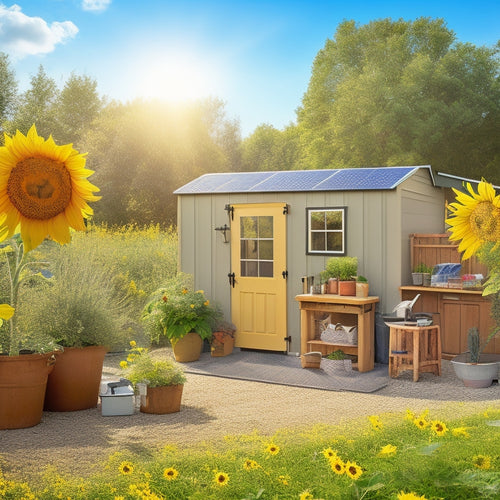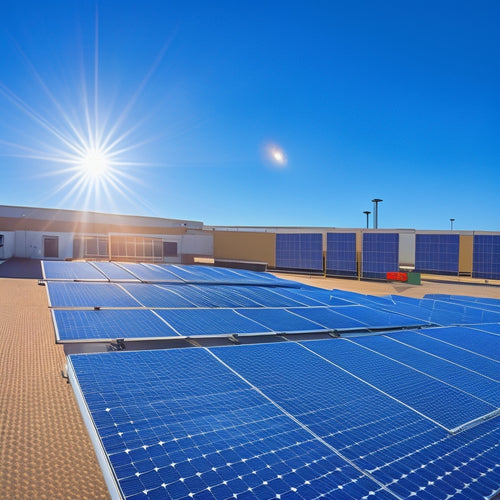
Solar Stills Vs Traditional Water Purification Methods
Share
When comparing solar stills to traditional water purification methods, you'll find several intriguing differences. Solar stills require a low initial investment and use renewable energy, making them cost-effective and eco-friendly. They also demand minimal maintenance and are simple to operate, leading to long-term savings. In contrast, traditional systems involve higher costs, ongoing repairs, and maintenance. The effectiveness of each method depends on your water source, with solar stills ideal for rainwater while traditional techniques work better for surface water. Understanding the unique benefits of each option can guide your decision in selecting the best purification method for your needs.
At a Glance
- Solar stills have low initial setup costs, while traditional methods require significant investments in specialized equipment and installation.
- Long-term maintenance of solar stills is minimal, reducing ongoing costs compared to traditional systems that require regular repairs and filter replacements.
- Solar stills utilize renewable energy, significantly lowering carbon footprints and minimizing environmental impact compared to energy-intensive traditional purification methods.
- The design of solar stills is simple and efficient, enabling effective water collection using natural processes without complex machinery.
- Water source characteristics are crucial; solar stills are effective for rainwater, while traditional methods suit surface or groundwater with specific contaminant profiles.
Cost-Effective Water Solution
When considering cost-effective water solutions, it's crucial to evaluate both initial setup costs and long-term maintenance savings.
Solar stills typically require a lower upfront investment compared to traditional purification methods, especially when considering their reliance on renewable energy sources like solar-powered systems for effective purification.
However, their minimal maintenance needs can lead to significant savings over time, making them an attractive option for sustainable water purification.
Initial Setup Costs
Although both solar stills and traditional water purification methods serve the essential function of providing clean water, their initial setup costs can vary considerably.
When considering solar stills, your initial investment is generally low. You'll likely need simple materials like plastic sheets, containers, and gravel, which are often readily available. This makes solar stills an attractive option for those seeking a cost-effective solution with minimal setup requirements.
On the other hand, traditional water purification systems, such as reverse osmosis or ultraviolet purification units, require a more significant initial investment. These systems often involve purchasing specialized equipment and installation costs, which can add up quickly. Additionally, they may necessitate ongoing utilities, further increasing your upfront expenses.
When evaluating your options, think about not just the initial costs but also the resources you have on hand. If you're looking for a straightforward, low-cost way to purify water, solar stills can be an appealing choice.
However, if you prioritize efficiency and have the budget for it, traditional methods might be more suitable in the long run.
Long-Term Maintenance Savings
Long-term maintenance savings play an essential role in determining the overall cost-effectiveness of water purification methods.
When you evaluate solar stills against traditional systems, the differences in maintenance can considerably impact your long-term expenses. Solar stills often boast long-term durability due to their simple design and reliance on sunlight, which means fewer components that can fail or require replacement.
In contrast, traditional methods, such as reverse osmosis or chemical purification systems, may entail ongoing costs related to filter replacements, chemical supplies, and potential repairs. These systems often come with complex maintenance strategies that necessitate regular monitoring and intervention.
By choosing solar stills, you can reduce your maintenance burden. With minimal moving parts and no need for electricity, these systems are less prone to breakdowns and costly repairs.
You'll find that the time and resources saved on maintenance can be redirected toward other important aspects of your life, giving you greater autonomy and peace of mind.
Ultimately, evaluating long-term maintenance savings can guide you to a more cost-effective and sustainable solution for your water purification needs.
Eco-Friendly Water Production
When considering eco-friendly water production, you should assess the environmental impact of various purification methods.
Solar stills, for instance, employ renewable energy and have a lower carbon footprint compared to traditional methods.
Additionally, solar water purifiers effectively remove harmful pathogens using UV-C LED technology, making them a sustainable option for safe drinking water.
Evaluating the sustainability of resources used in these processes can help you make informed decisions about water purification in an environmentally conscious way.
Environmental Impact Comparison
In recent years, the environmental impact of water purification methods has come under scrutiny as the need for sustainable solutions grows. You might find yourself wondering how solar stills and traditional methods stack up against each other.
Solar stills utilize solar energy, making them eco-friendly and requiring minimal resources. They operate on the principle of evaporation and condensation, producing fresh water without harmful emissions. This method is particularly significant in regions facing water scarcity, as it relies on a renewable resource.
In contrast, traditional purification methods often involve chemical treatments and energy-intensive processes. These can generate waste and contribute to environmental degradation, impacting ecosystems and public health. Additionally, the extraction and processing of resources for traditional systems can lead to unsustainable resource management practices.
When considering the environmental impacts, solar stills emerge as a more sustainable option. They not only leverage natural energy but also mitigate the risks associated with chemical pollutants and resource depletion.
As you evaluate your choices for water purification, the ecological footprint of each method should play an important role in your decision-making process.
Sustainability of Resources
With the growing emphasis on sustainability, the resources used for water production have become a focal point in evaluating purification methods. Traditional water purification often relies on methods that contribute to resource depletion and can be energy-intensive.
In contrast, solar stills utilize renewable resources like sunlight, providing an eco-friendly option that aligns with sustainable practices. By utilizing solar energy, you actively engage in conservation efforts that promote ecological balance.
As water scarcity increases globally, employing green technology such as solar stills can enhance climate resilience, ensuring a steady supply of clean water without compromising the planet's resources.
Focusing on environmental stewardship, solar stills contribute to ecosystem preservation by minimizing the carbon footprint associated with resource extraction and energy consumption. This approach not only satisfies immediate water needs but also supports long-term sustainability goals, nurturing a healthier planet for future generations.
Ultimately, as you consider water purification methods, remember that choosing solutions that prioritize renewable resources and sustainable practices can greatly impact resource conservation and ecological health. Embracing these methods enables you to make responsible choices for both your needs and the environment.
Unique Design Benefits
Solar stills showcase innovative water collection techniques that effectively utilize solar energy.
Their design not only maximizes water yield but also minimizes environmental impact compared to traditional methods. By utilizing simple materials and natural processes, solar stills offer a sustainable solution for purifying water.
Additionally, they align with renewable energy solutions that enhance water independence and reduce operational costs, making them an appealing option for communities seeking reliable clean water access.
Innovative Water Collection
Innovative water collection methods, like solar stills, offer distinct advantages over traditional purification techniques. One key benefit is their ability to leverage natural resources efficiently. For instance, solar stills employ sunlight to evaporate water, thereby purifying it without relying on complex machinery or chemicals. This makes them particularly appealing for areas where access to technology and energy sources is limited.
Moreover, integrating rainwater harvesting systems enhances your water collection capabilities. By capturing runoff during rainfall, you can supplement your water supply considerably. This not only conserves groundwater but also minimizes the risk of contamination associated with traditional sources.
Additionally, these methods can extract atmospheric moisture, providing an innovative solution for arid regions. Atmospheric water generators can convert humidity into potable water, ensuring a sustainable supply even in challenging climates.
Minimal Environmental Impact
Utilizing natural processes, solar stills demonstrate a remarkably minimal environmental impact compared to traditional water purification methods. Unlike conventional systems, which often rely on energy-intensive processes, solar stills utilize the sun's energy to purify water. This passive method not only conserves energy but also reduces greenhouse gas emissions.
Moreover, when you integrate solar stills with rainwater harvesting and greywater recycling, you create a sustainable ecosystem for water management. By collecting rainwater, you can supply the stills with clean, free resources, minimizing the need for additional water sources.
Greywater recycling further enhances this system, allowing you to repurpose wastewater from sinks or showers, converting it into a viable source for purification.
This closed-loop approach not only decreases reliance on municipal water supplies but also lessens the burden on your local environment.
Solar stills stand out for their simplicity and efficiency, aligning with a freedom-driven lifestyle that seeks autonomy from traditional infrastructures. By choosing this method, you're not just purifying water; you're actively participating in a sustainable future that respects and preserves the planet's resources.
Selecting Based on Water Source
When choosing a water purification method, the characteristics of your water source play a vital role. Different sources, such as rivers, lakes, or groundwater, present unique challenges that affect the suitability of solar stills versus traditional methods.
For instance, evaluating the water quality and potential contaminants can guide you in selecting the most effective approach, as seen with battery water maintenance which highlights the importance of using appropriate resources to guarantee peak performance.
Water Source Characteristics
Choosing the right water source is vital for effective purification, as the characteristics of that source can greatly influence the treatment method you select. When evaluating potential water sources, focus on two significant factors: water quality and source reliability.
Water quality encompasses various elements, including contaminants, turbidity, and pH levels. The presence of specific impurities can dictate the purification technology you'll need. For instance, if you're sourcing water from a river that's heavily polluted, you might require a more substantial method than if you were drawing from a well with consistently clean water.
Source reliability also plays an important role. If you can't guarantee a consistent supply, your chosen purification system may become ineffective. A reliable source guarantees you have adequate water for your needs, making it easier to maintain your purification system's operations.
Ultimately, understanding both the water quality and source reliability allows you to make informed decisions about which purification method to pursue. This knowledge equips you to select an approach that not only meets your immediate needs but also aligns with your long-term goals for sustainability and independence in water sourcing.
Purification Method Suitability
Selecting the right purification method hinges on the specific characteristics of your water source. Understanding these traits allows you to evaluate purification effectiveness and user accessibility, ensuring you choose a method that meets your needs.
Here's a comparison of common water sources and suitable purification methods:
| Water Source | Suitable Method | Purification Effectiveness |
|---|---|---|
| Surface Water | Traditional Filtration | Moderate to High |
| Groundwater | Reverse Osmosis | High |
| Rainwater | Solar Still | Moderate |
| Contaminated Sources | Chemical Treatment | High |
For surface water, methods like traditional filtration work well, but may not eliminate all contaminants. Groundwater often requires reverse osmosis for its high purification effectiveness. If you're collecting rainwater, solar stills might be your best bet for simplicity and accessibility, even if the effectiveness is moderate.
Contaminated sources demand more resilient solutions, like chemical treatment, ensuring high purification effectiveness. By understanding the characteristics of your water source, you can confidently select a purification method that balances effectiveness and accessibility, granting you the freedom to access clean water whenever you need it.
Higher Energy Efficiency
When comparing solar stills to traditional water purification methods, you'll find that solar stills have minimal energy requirements.
This efficiency is particularly important in areas where energy resources are scarce or expensive. By utilizing solar energy, these systems can provide a sustainable solution for clean water without the high energy costs associated with conventional methods.
Minimal Energy Requirements
Solar stills offer an innovative approach to water purification that requires minimal energy input compared to traditional methods. Utilizing solar energy, these systems capitalize on the evaporation process to purify water effectively.
Unlike conventional purification methods that often depend on electricity or fuel, solar stills operate as passive systems, making them especially appealing in remote or off-grid areas.
The design simplicity of solar stills enhances user accessibility; they can be constructed with readily available materials, allowing anyone to implement this technology. Their climate adaptability means they function efficiently in various environments, leveraging sunlight to maintain operational efficiency.
When conducting a performance comparison, you'll find that while traditional methods may yield faster results, solar stills excel in energy conservation. They require no ongoing energy costs, which is critical for sustainable water purification.
Frequently Asked Questions
How Long Does It Take to Purify Water Using Solar Stills?
Purifying water with solar stills typically takes several hours to a day, depending on the evaporation rate. When you compare efficiency, solar stills can be slower than some traditional methods, but they offer sustainable benefits.
Can Solar Stills Work in Cloudy or Rainy Conditions?
Yes, solar stills can work in cloudy or rainy conditions, but their solar efficiency decreases considerably. Weather impacts the evaporation process, leading to slower purification rates compared to sunny days, which are more effective for water collection.
What Maintenance Is Required for Solar Stills?
You'll need to regularly clean the glass and basin to guarantee efficiency. Consider design improvements to enhance performance, and remember that cost efficiency hinges on diligent maintenance, making certain your setup remains a reliable source of pure water.
What Types of Contaminants Can Solar Stills Remove?
Solar stills effectively remove several contaminant types, including salts, heavy metals, and pathogens, enhancing purification efficiency. However, they may struggle with certain chemicals, so understanding their limitations is essential for ensuring safe drinking water.
Are Solar Stills Portable for Outdoor Use?
Imagine a compact oasis under the sun. With thoughtful solar still design, you'll find outdoor portability makes it easy to transport. These devices offer freedom for water purification wherever you go, embracing nature's elements efficiently.
Explore More
In choosing between solar stills and traditional purification methods, consider the long-term benefits. Imagine a sunflower turning its face toward the sun; just as it thrives by utilizing natural energy, solar stills offer an eco-friendly, cost-effective solution for water purification. With their unique design and higher energy efficiency, they adapt beautifully to various water sources. Ultimately, embracing solar stills can lead to sustainable hydration, much like the sunflower's quest for sunlight guarantees its growth and vigor.
Related Posts
-

How to Achieve a Zero-Waste Lifestyle for a Greener Tomorrow
To achieve a zero-waste lifestyle, start by adopting the principles of refusing, reducing, reusing, and recycling. Sw...
-

Building an Emergency Backup Solar Power System in 5 Essential Steps
Building an emergency backup solar power system involves five key steps. First, assess your daily energy needs to ide...
-

Essential Solar Panel Mounts for Commercial Properties
When it comes to essential solar panel mounts for your commercial property, durability and wind resistance are key fa...


